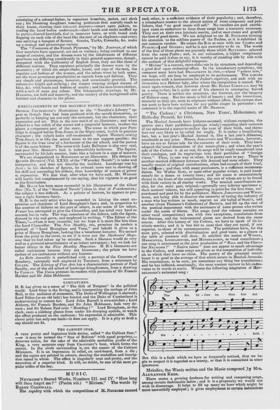COSTUMES.
PRINTS of costumes have always been in favour with the public ; and naturally so, for they are not only attractive to the eye, but entertaining to the mind : when, like those of Rome by PINELIJ, they combine de- lineations of the scenery, habitations, and customs of a country, they present pictures of national peculiarities so vivid and striking, that words fail to convey an adequate idea of the scene. Of this description of works there are two classes now in the course of publication,—one de- signed as patterns for MARADAN, and other fashionable dress-makers, to work from, in the production of fancy-dresses, and equally useful to the inventors of theatrical costumes ; the other, bond fide representations of the habiliments actually worn by other nations. To the former class belong the series of superb costumes by M. MANSION, entitled " Fancy Ball Dresses," of which we have had occasion to speak in terms of admiration, and with whose style most of our readers are familiar, from having seen the plates in the prire shop windows for these few months past. The same clever artist (who is a Frenchman, by the way) has commenced a new series of female costumes, denominated " National Ball Costumes," which are got up in the same splendid style of colouring, and are equally- distinguished for richness of effect and costliness of materials and or- nament. Nor are the gentlemen forgotten ; they may, on the occasion of a fancy ball, gratify their taste for gorgeous attire by selecting a dress- from amongst a series of " Foreign Costumes,"—a work forming a com- panion to the one before-mentioned, and of the same sumptuous cha- racter. These costumes bear much the same relation to those actu- ally worn in the countries named on each, as do the character dresses of a theatrical wardrobe. 1ACKERMANN'S " Select Costumes " belong to the other class ; and, we doubt not, are faithful, as far as. the fashion of the habiliments is concerned, though they are
coloured rather highly, in order to catch the vulgar eye. These plates consist of groups of figures ; the others have only one ; and that they are the ordinary dresses of the people, is evident from their peculiarity, amounting occasionally to uncouthness, for they display more ingenuity than taste. Here are a family of "Saxe Altenbourgersr
consisting of a colossal father, in capacious breeches, jacket, and cloth cap ; his blooming daughters wearing petticoats that scarcely reach to their knees, showing their coloured drawers—smart open jackets, re- vealing the laced bodice underneath—their heads and necks mused up in party-coloured kerchiefs, tied in immense bows, or with broad ends flapping on each side of the head like the ears of an elephant—and every one carrying a bouquet of flowers. Greeks, Turks, Cossacks, &c. make up a strange and picturesque variety. The " Costumes of the French Pyrenees," by Mr. JOHNSON, of which four numbers have appeared, are not so various ; being confined to one range of country, and the dresses worn by the inhabitants of different provinces not differing considerably in their general appearance, though, compared with the uniformity of English dress, they are like those of different nations. They represent principally the dresses worn by the peasantry ; of which the ample cloaks, hoods, and caps of the men, the capulets and bodices of the women, and the sabots worn by both sexes, are the most prominent peculiarities as regards form and fashion. They are simple and picturesque, however, and occasionally graceful. The colours are bright and striking ; the women wearing striped dresses of blue, &c. with hoods and bodices of scarlet ; and the men brown clothes, with a sash of some gay colour. The lithographic drawings, by Mr. HARDING, are bold and masterly, and the scenery of the background adds interest and character to the plates.



























 Previous page
Previous page